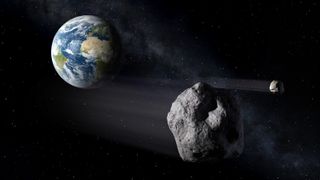Asteroid hunters worry megaconstellations might interfere with planetary defense
A new survey reveals the trepidations of planetary defense experts.

Adding to the astronomy community's general apprehension about the growing number of satellites in low Earth orbit (LEO), a number of planetary defense scientists and researchers have voiced their own concerns about the topic.
Apollo Academic Surveys and Carrie Nugent of the Olin College of Engineering in Massachusetts surveyed planetary defense experts on a range of topics regarding near-Earth asteroids (NEA) and comets. Of the 34 experts polled, all of them said they were at least slightly concerned about the effect of satellite overcrowding on asteroid detection; 24% identified as extremely concerned.
"Studies (e.g. Mroz et al. 2022) have shown that LEO satellites can severely affect observations taken during twilight, and that is an important parameter space for NEO search," wrote one anonymous survey participant.
Related: NASA's DART asteroid-impact mission explained in pictures
Another respondent pointed to the potential issue of launching a mitigation mission — for example, an asteroid deflector like NASA's DART mission — through a "flood of artificial satellites."
"I think it's absolutely terrible that nothing concrete is being done to combat this issue," wrote Cristina Thomas of Northern Arizona University. "This is only going to get worse and make a lot of problems for ground-based discovery."
But there is hope yet. Some experts pointed to space-based observation systems, such as the NASA space telescope NEO Surveyor that the agency hopes to launch in 2028, as the future of monitoring potential threats. "Space-based assets are the correct advancement of NEO discovery. Ground-based search assets are of diminishing importance," wrote another anonymous survey participant.
Get the Space.com Newsletter
Breaking space news, the latest updates on rocket launches, skywatching events and more!
And as for ground-based observations, researchers may be able to develop software to filter out most interference from artificial satellites, just as astronomical observers have worked to do.
"A well-designed, NEO-focused survey can be made robust against losing occasional images (or fractions of images) due to satellite trails," wrote Eric Christensen of the University of Arizona, who serves as the principal investigator of the Catalina Sky Survey, one of the two asteroid-spotting programs with the most detections to its name, according to NASA. "I've estimated that a fully built-out Starlink megaconstellation may degrade Catalina Sky Survey's detection efficiency by a few tenths of a percent."
But he does note that other astrophysical surveys "may be more susceptible to additional 'noise' from satellite trails."
The survey results have been published by Apollo Academic Surveys.
Follow Stefanie Waldek on Twitter @StefanieWaldek. Follow us on Twitter @Spacedotcom and on Facebook.
Join our Space Forums to keep talking space on the latest missions, night sky and more! And if you have a news tip, correction or comment, let us know at: community@space.com.

Space.com contributing writer Stefanie Waldek is a self-taught space nerd and aviation geek who is passionate about all things spaceflight and astronomy. With a background in travel and design journalism, as well as a Bachelor of Arts degree from New York University, she specializes in the budding space tourism industry and Earth-based astrotourism. In her free time, you can find her watching rocket launches or looking up at the stars, wondering what is out there. Learn more about her work at www.stefaniewaldek.com.
